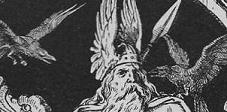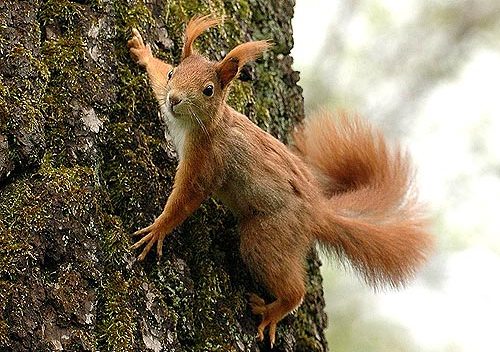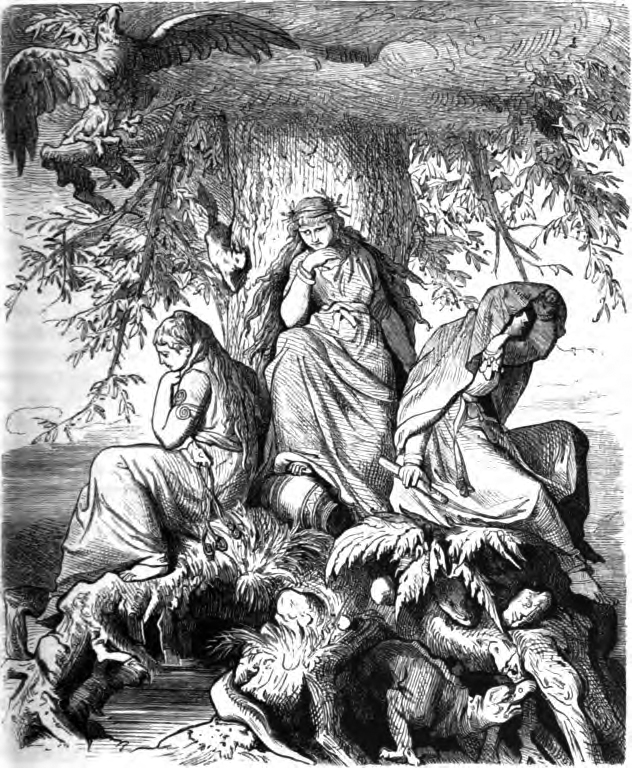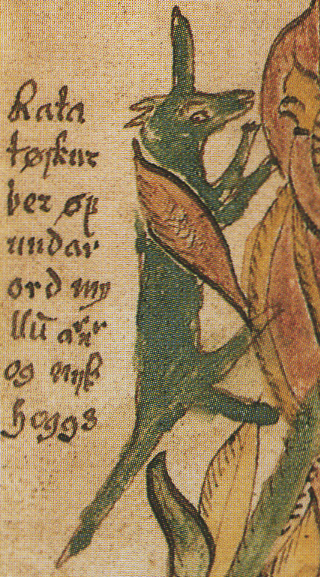The Poetic Edda: A Study Guide
The Speech of the Masked One

[PREVIOUS][MAIN][NEXT]
[HOME]
MS No. 2365 4to [R]
AM 748 I 4to [A]
Normalized Text:
er renna skal
at aski ygdrasis;
arnar orð
hann skal ofan bera
ok segja niþhargvi niðr.
32. Raratoskr heitir íkorni,
er renna skal
at aski yggdrasils;
arnar orð
hann skal ofan bera
ok segja niðhög niðr.
32. Ratatoskr heitir íkorni,
er renna skal
at aski Yggdrasils;
arnar orð
hann skal ofan bera
ok segja Niðhöggvi niðr.
in Icelandic Poetry
“The Song of Grimnir”
The Yale Magazine, Vol. 16
“The Song of Grimner”
XXXII.
The Squirrel who with nimble skill,
Sports thro' the ash of Yggdrasil,
The mandates of the Eagle brings,
That plumes aloft his spreading wings,
To where Nidhogger[1] far
beneath,
Coils in many a shining wreath.
[1]
NIDHOGGER, the name of a serpent.
The squirrel that runneth
on lofty Yggdrasill,
And down to Nidhauggr
bringeth the eagle's words,
Is Ratatoskr;
in Edda Sæmundar Hinns Frôða
“The Lay of Grimnir”
in Corpus Poeticum Boreale
“The Sayings of the Hooded One”
which has to run
in Yggdrasil’s ash;
he from above
the eagle’s words must carry,
and beneath to Nidhögg repeat.
Rat-tusk[1]
is the name of the squirrel
that runs up and down the ash Ygg's-steed:
he carries the Eagle's words down and
tells them to the Serpent below.
[1]
Rata-toskr heitir ikorni, R (supernumerary)
in Edda Saemundar
“The Sayings of Grimnir”
in The Poetic Edda
“Grimnismol: The Ballad of Grimnir”
which runs in Yggdrasil's ash :
he bears the eagle's words from above
and to Fierce-stinger tells below.
32. Ratatosk [1] is the squirrel who there
shall run
On the ash-tree Yggdrasil;
From above the words of the eagle he bears,
And tells them to Nithhogg beneath.
in The Poetic Edda
“The Lay of Grimnir”
in The Elder Edda
“The Lay of Grimnir”
which runneth ay
about the ash Yggdrasil:
the warning words of the watchful eagle
he bears to Níthhogg[2] beneath.
[1] "Rat Tusk."
[2] See "Völuspá." The dragon is here conceived as gnawing the roots of Yggdrasil. See St. 36.
Rat-Tusk is the squirrel who shall run up
Yggdrasil the ash tree,
Bearing with him the words of the eagle
Down to Nidhögg beneath.
in The Poetic Edda
“Grimnir’s Sayings”
in The Poetic Edda, Vol. III: Mythological Poems
“The Lay of Grimnir”
upon the ash of Yggdrasill; the eagle's word he must bring from above
and tell to Nidhogg below.*
32. Auger’s tusk the squirrel is called,
who must scurry along Yggdrasill’s Ash.
The eagle’s messages he must transmit
from above and inform malice Striker underground.
|
2011 Andy Orchard The Elder Edda: A Book of Viking Lore 'The Lay of Grimnir" |
32. ‘Ratatosk is the name of the squirrel who has to run,
over the ash Yggdrasil;
the eagle’s words he must bring from above,
and say to Spite-striker below.

European tree squirrel (Sciurus vulgaris)
[HOME][GRÍMNISMÁL]
| Þá mælti Gangleri: "Hvat er fleira at
segja stórmerkja frá askinum?" Hárr segir: "Margt er þar af at segja. Örn einn sitr í limum asksins, ok er hann margs vitandi, en í milli augna honum sitr haukr, sá er heitir Veðrfölnir. Íkorni sá, er heitir Ratatoskr, renn upp ok niðr eftir askinum ok berr öfundarorð milli arnarins ok Níðhöggs, en fjórir hirtir renna í limum asksins ok bíta barr. Þeir heita svá: Dáinn, Dvalinn, Duneyrr, Duraþrór. En svá margir ormar eru í Hvergelmi með Níðhögg, at engi tunga má telja. |
Then said Gangleri: "What more mighty wonders
are to be told of the Ash?" Hárr replied: "Much is to be told of it. An eagle sits in the limbs of the Ash, and he has understanding of many a thing; and between his eyes sits the hawk that is called Vedrfölnir. The squirrel called Ratatöskr runs up and down the length of the Ash, bearing envious words between the eagle and Nídhöggr; and four harts run in the limbs of the Ash and bite the leaves. They are called thus: Dáinn, Dvalinn, Duneyrr, Durathrór. Moreover, so many serpents are in Hvergelmir with Nídhöggr, that no tongue can tell them. |
The most obvious interpretation of this stanza, of course, is the literal one. Ratatoskr is a squirel who scurries up and down the World-Tree carrying malicious gossip between the eagle at the top of the tree, and the serpent Nidhögg at its base. The eagle is most often identified with the eagle Veðrfölnir, sitting atop Yggdrasil, with a hawk perched between its eyes. As they are mentioned in close proximity in Gylfaginning 16, several scholars have supported the theory that a lost stanza must have occured before this one.
The serpent Nidhögg also appears in Völuspa 39 & 66. Ratatöskr is otherwise unknown, outside of Gylfaginning 16, which uses this stanza as its source.
The name Ratatosk is most often translated as "Bore-tooth" from rata, "to drill" and toskr, "tusk, tooth" (as in John Lindow, Norse Mythology, 2002). Henry Adams Bellows (1923) translates the name as "Swift-tooth." Other translations have been purposed, but have either fallen out of fashion or have been soundly refuted on linguistic grounds.
Cleasby/Vigfusson Dictionary of Old Icelandic (1874):
|
|
1903 Ferdinand Detter and Richard Heinzel, Saemundar Edda, Vol. 1:
32 Ratatoskr 'den Zahn des Bohrers Rati', Hav. 104. Weder rati noch toskr sind als Âppellativa belegt. Bugge Studier 1 460ff., The Home of the E. P. XXIV hält das Wort für altenglisch von raet und tusk.32 Ratatoskr 'the teeth of the drill Rati', Hávamál 104. Neither rati nor toskr otherwise occur as appellatives. Sophus Bugge, Studies 1, pp. 460ff., In The Home of the Eddic Poems, ch. 24, Bugge holds that the word derives from the Old English 'rat' and 'tusk'.
32 4—6. Bergmann und Vigfusson erinnern an die Fabel Phaedrus II 4, wo eine Wildkatze zwischen dem Adler auf der Spitze und dem Eber am Fusse des Baumes Unfrieden stiftet. Die Verbreitung des Motives zeigt Falk, Aarböger 1891 S. 294.32 4-6. Bergmann and Vigfusson remember the fable in Plato's Phaedrus II 4, where a wildcat between the eagle at the top and the boar at the foot of the tree donates strife. Falk shows the distribution of the motif (Aarböger 1891 p. 294.)
In the glossary accompanying "Our Fathers' Godsaga" (1887), Viktor Rydberg writes:
Ratatosk (“Rati's tooth”, compare Heimdall's byname Gullintanni, 'Gold teeth'), Heimdall's fire-auger, in the poem Grímnismál symbolized as a squirrel (which is still a symbol of fire in folk-belief) that runs from Yggdrasil's crown down to its root.
In his Investigations into Germanic Mythology, Vol. I, no. 82 and 89, Rydberg suggests that the verb rata meaning "to travel," "to move about" (originally vrata, Goth. vrâton, to travel, make a journey) can be traced to an ancient Germanic word which meant to turn or twist (Fick, Wörterbuch, 3, 294). He observes that Hávamál 106, Grímnismál 32, and Skáldskaparmál testify that the mythical name Rati was connected with a boring activity.
In Hávamál "Rati's mouth" gnaws the tunnel through which Odin, in the guise of an eagle, flies away with the mead-treasure concealed in the "deep dales" at Fjalar's under the roots of the world-tree. In the allegorical Grímnismál strophe it is "Rati's tooth" (Ratatoskr) who lets the mead-drinking foe of the gods near the root of the world-tree find out what the eagle in the top of the world-tree (Odin) resolves and carries out in regard to the same treasure. In Skáldskaparmál, the name is given to the gimlet itself which produced the connection between Odin's world and Fjalar's halls. The gimlet has here received the name of the boring "traveller," of him who is furnished with "golden teeth." Hence there are good reasons for assuming that in the epic of the myth it was Heimdall-Gullintanni (gold tooth) himself whose fire-gimlet helped Odin to fly away with his precious booty. In Rigveda, Heimdall's counterpart Agni, the god of friction fire, plays the same part. The "tongue of Agni" has the same task as "Rati's mouth" in the Norse records. The sacred mead concealed in the mountain with the Dasyus, enemies of the world; but Agni split the mountain open with his tongue, his ray of light penetrated into the darkness where the liquids of nourishment were preserved, and through him they were brought to the light of day, after Trita (in some passages of Rigveda identical with Vata) had slain a giant monster and found the "cows of the son of the work-master" (cp. Rigveda, 5: 14, 4; 8: 61, 4-8 ; 10: 8, 6-9). This mirrors Odin's activity in the mead-myth.
In the Old Norse sources, there are two differing accounts of the myth when Odin met the giantess Gunnlod in a mountain recess and recovered the stolen mead of poetry from her. One occurs in Hávamál 101-106, the other in Skáldskaparmál of the Prose Edda.The statements of the older poetic source (Hávamál) have, strange to say, been almost wholly overlooked in favor of the later presentation in Snorri Sturluson's Skáldskaparmál, which cannot be fully reconciled with the earlier account. In 1877, justice was done for the first time to Hávamál in the excellent analysis of the stanzas in question made by Professor M. B. Richert, in his "Attempt to explain the obscure and not understood passages in the Poetic Edda." [Försök til belysning af mörkare och oförstådda ställen den poetiska eddan, Upsala Universitets Årsskrift, 1877]. Richert's interpretation of Hávamál stanzas 104-110 "imply a version where Odin arrives at Suttung's halls as a seemingly respectable wooer and goes through a marriage ceremony with Gunnlod, according to David Evans, in his commentary to Hávamál (1986), p. 120.
The adventure undertaken by Odin in Hávamál is extremely dangerous, and he ran the risk of losing his head (st. 106). For this reason, before entering Suttung-Fjalar's halls, he has secured an egress, through which he would be able to fly with the skaldic mead, if possible, as his booty. There is no easy admittance to the rocky abode where the mead-treasure so much desired by all powers is concealed. The dwelling is, as Eyvind tells us, situated in an abyss, and the door is, as another record tells us, watched. But Odin has let Rati "gnaw" a tunnel through the mountain large enough to give him room to secretly escape (str. 106). In Snorri's account, he enters as a snake and exits as an eagle. In a verse by the skald Eyvind, preserved in Skáldskaparmál, Odin is said to "flying bear" the mead of poetry "from Surt's deep-dales" (surts sökkdalir), making it probable that Suttung and his clan are fire-giants akin to Surt. Thus Odin is in grave danger.
As told in Skáldskaparmál, Odin must descend down into the mountain stealthily so that he and Suttung's daughter Gunnlöd can meet privately; therefore the author makes him use the drilled hole to enter the mountain. From the account in Hávamál, it appears, on the contrary, that Odin entered the giant's hall in the usual manner through the door, abeit disguised as the expected bridegroom, and afterward avails himself of the tunnel made by Rati to get out.
Hávamál first states that Odin seeks the giant, and then tells how he enters into conversation and develops his eloquence in Suttung's halls, and how, while he sits in the golden high-seat (probably opposite the host, as Richter has assumed), Gunnlod hands him the precious mead. Then is mentioned for the first time the way made for him by Rati, and this on the one hand in connection with the "evil compensation" that Gunnlod, the devoted woman whom he had embraced, received from him, and on the other hand in connection with the fact that his flight from the mountain was successful, so that he could escape with the mead eventhough his life was in danger. There were giants' paths both above and below the secret path by which he escaped. That Odin took the oath of faithfulness on the holy ring, that there was a regular wedding feast with the usual questions on the next morning in regard to the well-being of the newly-married couple -- all this Skáldskaparmál does not mention, nor does its premise allow it to do so.

'Downright Squirrelly'
Allegorical Explanations and Other Observations
on Grímnismál 32
|
Foreign
Quarterly Review 1828 A Review of Finn Magnusen's "The Edda Doctrine and its Origin" |
|
 |
"The mythos of Yggdrasil is contained in the preceding passages; and northern mythologists in general, and our author in particular, have been no where more fortunate than in their explanation of it. ...In his explication, the greater portion is, we think, correct; some of the author's solutions, however, do not appear to us wellfounded. Mr. Magnusen is certainly in error when, following Gräter, he says, the branches of the mundane tree typify the æther. If by æther we are to understand the highest region of the atmosphere, this cannot be; for a little after, our author correctly supposes that to be denoted by the wind-stilling hawk. The true view of this portion of the symbol, we apprehend, is, that the central root of Yggdrasil being in Niflheim, the murky dismal region, which in this system, as in the Grecian, lies beneath the earth. The stem, if it denotes not the earth itself, passes through the earth, over which it rises to a certain height (perhaps to the region of clouds) before it casts out branches; the sum of which represents the whole aerial space, of which the lower part is represented by the eagle, the upper by the hawk. Again, in his explanation of the squirrel Ratatosk, we cannot fully agree with our author. Ratatosk is said to run up and down through the boughs, carrying the words of the eagle to Nidhug. This eagle surely can be no other than him between whose eyes the hawk sits. But Mr. Magnusen, who so justly rejects the metaphysical notion of Gräter, (viz. that Ratatosk is 'Fame',) contending that it is, like the rest, to be explained physically, and taking it to denote snow-flakes, etc. understands by the eagle, not him who sits in the tree, but the eagle who, in 'Vafthrudnis-mal,' (a poem in which there is not the slightest allusion to Yggdrasil,) abiding in the north, is the producer of wind. "Hræsvelg
hight the giant, This confusion is introduced without necessity; for supposing Ratatosk to be (what we are by no means sure of) the raindrops, hail, etc. may they not as well be the words of the aerial eagle? |
Henry Bellows Adams, The Poetic Edda (1923):
"The hypothesis that Ratatosk represents 'the undying hatred between the sustaining and the destroying elements —the gods and the giants'— seems a trifle far-fetched."
Frederic T. Wood, "Grímnismál 33", Scandinavian Studies, Vol. 17 (1943);
"It has been plausibly suggested that the squirrel is not really carrying malicious words between eagle and dragon, as Snorri seems to have thought; the squirrel is rather betraying the incautious chatter of the talkative eagle, Grimnismal 33."
Squirrels: The Animal Answer Guide (2006) by Richard W. Thorington Jr. and Katy Ferrell:
"The role of Ratatosk is probably derived from the habit of the European tree squirrel (Sciurus vulgaris) to give a scolding alarm call in response to danger. It takes little imagination for you to think that the squirrel is saying nasty things about you."
As Thorington and Ferrell note above, squirrels often emit a warning cry when danger is present. If the squirrel Ratatoskr is a symbolic representation of Heimdall, the golden-toothed god, this chatter may refer to his function as watchman. In that case, the eagle at the top of the tree is Odin, who took eagle-form to escape from Surt's deep-dales (surts sökkdalir) with the mead of poetry. In Hávamál 104, it is the drill rati that bores the hole through which Odin makes his escape. The squirrell is named Ratatoskr "Rati's tooth" and represented as a gnawing animal.
In the poem Hrafnagaldur Ódinns, when Ragnarök appears imminent, Odin sends Heimdall as the head of a trio of emissaries to the underworld to obtain information concerning the fate of the world from a goddess there. Tears are her only response. When Heimdall returns, it is his duty to relay the information to the gathered gods. Loki informs the goddesses. Heimdall's act of journeying to the underworld at Odin's behest and returning with information obtained there runs parallel to the activity of Ratatosk.
At the end of Hrafnagaldur Óðinns, Heimdall (literally "light of the world") is compared to a rooster, blowing his horn as the sun rises, driving the demons of darkness away. In the Norse religion, it is Heimdall's function to keep an eye (and an ear!) on the forces of darkness gathered around the northern root of the world-tree. In Grímnismál 34, these same forces appear to be represented by a throng of serpents, a not uncommon site in Niflhel (Völuspá 38-39). Heimdall provides an early warning should they gather and attempt to storm the Bifröst bridge. Heimdall will sound the alarm, blowing Gjallarhorn, at the dawn of Ragnarök (Völuspá 45). Based on the imagery in Hrafnagaldur Óðinns 25-26, it is likely that the golden cock Gullinkambi who perches high in Yggdrasil's branches is also a symbol of Heimdall, "the whitest god". The same cock appears by the name Vidofnir in Fjölsvinnsmál, and is said to be "all aglow with gold."
[PREVIOUS][MAIN][NEXT]
[HOME]